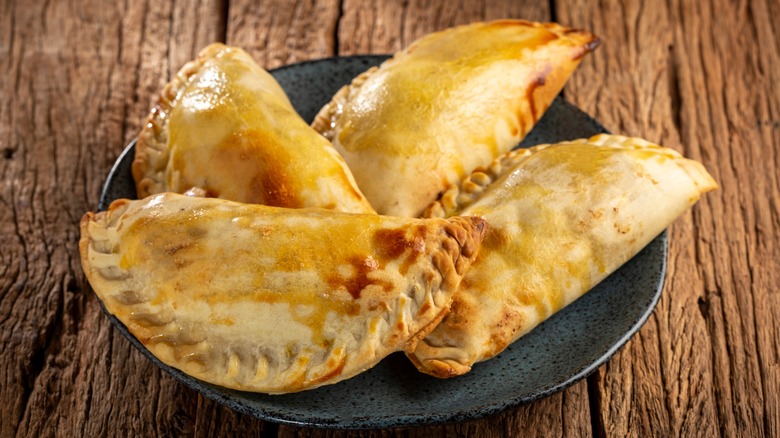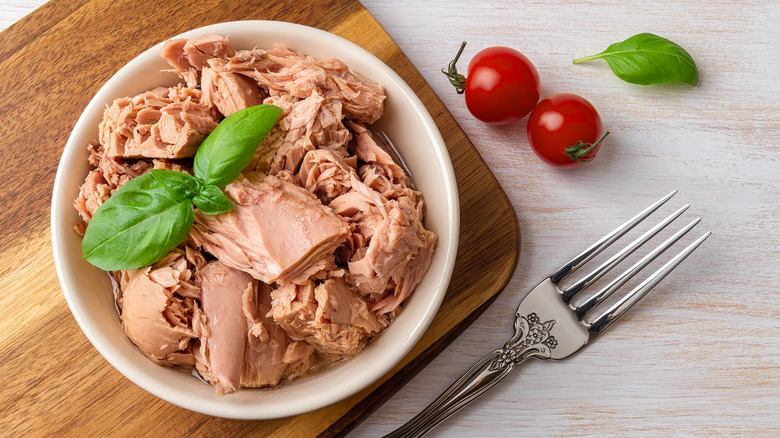The Classic Spanish Empanada Variation With Flavorful Canned Tuna
Traditional Latin American food is derived from a blend of Indigenous flavors and European influence, making it some of the most unique and culturally-rich food in the world. From Mexico to Argentina, there are many staple foods that help tie these Spanish-speaking countries together — one of them being the humble empanada.
Empanadas are one of the most satisfying foods to eat. When you crack through the golden-fried, crispy dough, you're rewarded with tender and flavorful meat on the inside. Mixed in with a few select veggies and spices, this makes an ideal pairing that's easy to wash down with a few beers at a party or while on a street walking tour in your favorite Latin city. However, whether you're frequenting street food carts in Latin America or ordering fresh empanadas from a sit-down place in Spain, you're likely to find beef empanadas sitting on your plate. Beef is by far the most popular filling when it comes to tasty empanadas, but one lesser-known variety is also worth seeking out.
Tuna fish empanadas are full of the Iberian flavors from which they originated. With olive-oil soaked fish, chopped bell peppers, tomatoes, olives, and several integral spices, this combination yields a rich yet fresh-tasting filling that will leave you craving more.
History of tuna empanadas
Empanadas have a long history attached to them that begins in the Northwestern region of Spain in Galicia. This autonomous community rests on the Atlantic Ocean and borders Portugal, both of which have significantly influenced the region's culture, including its food. Galicia has long been known for their seafood-rich dishes, like pulpo a la Gallega and mariscada. However, empanadas may be the most popular and widespread food to come out of this region. Originally, this dish was made for working-class people in the area, as they traveled well and provided sustenance.
Empanadas are thought to be descendants of the Middle Eastern meat pie, known as sfeehas. This Lebanese dish was brought to the country during the 1500s when Moors (a Muslim group that migrated to Europe) occupied Spain. The first mention of empanadas was found in a Catalan cookbook, and centuries have since solidified empanadas' significant place in Spanish culture.
As Spanish colonialism spread to the new world, empanadas, along with other foods, followed. Today, each country makes its empanadas slightly different, stuffing them with unique fillings and using different techniques to wrap and cook the dough.
Ingredients in tuna empanadas
To make authentic tuna empanadas, fatty tuna fish is needed as the base of the filling. Canned tuna works great in this recipe, but choosing the fish packed in olive oil is important, as it adds a richer flavor and more moisture to the empanadas. An additional protein, like ham or a hard-boiled egg, is sometimes included, but aside from this, lots of veggies and spices are common. These often include chopped bell peppers, tomatoes, onion, garlic, and capers. The spice blend is often as simple as salt, pepper, smoked paprika, and bay leaves. Some of these ingredients may vary or be substituted, but this is a lineup you're likely to find when traveling through Galicia.
Empanada dough made from scratch usually includes flour, olive oil, water, and salt — a simple mixture that yields a delicately textured dough with a wonderful crunch once baked. Luckily, a large batch of this succulent dish can be thrown together in about an hour, even if making the dough by hand.
How tuna empanadas are made and eaten
Making tuna empanadas is a simple process, even for beginners. The first step is to chop all your veggies and sautée them in oil. Once tenderized, the tuna, egg, and most of the seasonings are added to the hot pan, too. Once this mixture is thickened, it's cooled down while the dough is prepared.
You can either use store-bought puff pastry or choose to make your dough from scratch. Either way, once the dough is ready, it can be flattened and cut into small circles. A couple of tablespoons of filling can be spooned in, and the dough is folded over the mixture and sealed. The easiest way to seal the empanadas is by pressing down along the edges with the tip of a fork. Then, they're ready to be cooked. Traditionally, these empanadas are fried, but you can bake them as well. Once they turn golden, they can be moved onto serving platters.
Empanadas make a great party food or they can be enjoyed at la merienda, a designated time for an afternoon snack in Spain. They're a casual food that are eaten by hand and can be paired with an alcoholic beverage, like beer or wine, or alongside a pick-me-up coffee. They can be eaten solo, but they can also be a part of a delicious tapas spread. However you opt to enjoy these tasty tuna empanadas, make sure to make enough, as we guarantee everyone will be reaching for more.



